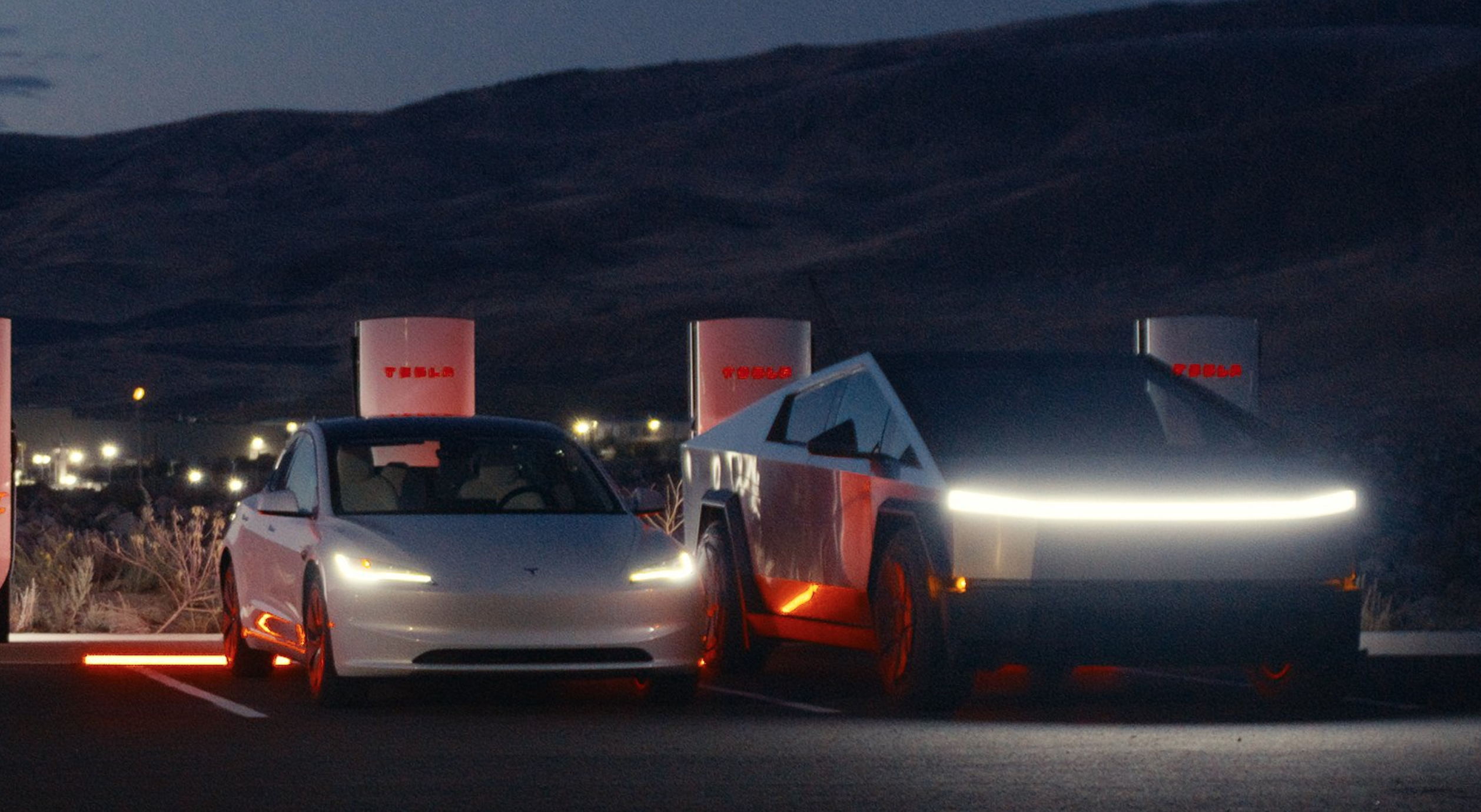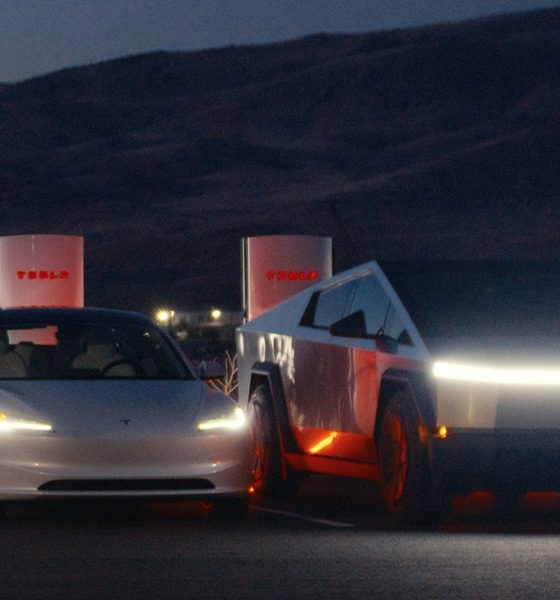Ahead of the rollout of V4-compatible power cabinets, Tesla has highlighted that faster charging speeds for the Cybertruck are now available at certain charging stations with V4 Supercharging posts.
On Friday, Tesla’s Charging account on X highlighted that the Cybertruck can now charge at speeds of up to 325kW at select Supercharger sites with V4 charging stalls. The news comes as Tesla prepares to start rolling out its V4 charging cabinets in early 2025, which will enable speeds of up to 500kW.
Tesla North American Charging Director Max de Zegher also reposted the news on X, clarifying that, eventually, all V4 posts with a V3 cabinet would enable 325kW charging speeds, and likely even in the coming weeks. He also points out that these Cybertrucks are charging at 400v at 325kW, though they’ll eventually be able to access the full capabilities of their 800v charging architecture with the arrival of the V4 cabinet.
Where can Tesla Cybertrucks charge at speeds of up to 325kW?
Below is the full list of initial sites where Tesla Cybertrucks can charge at 325kW, as shared by Tesla. The company also says it’s aiming to roll out access to even more locations.
- Lebec, CA
- Chemult, OR
- Columbus, GA – Macon Road
- Dayton, OH – North Springboro Pike
- Dunnigan, CA – County Road
- Lamoni, IA
- Wilsonville, OR
- Truckee, CA – Deerfield Drive
- Harrison, NY
- Farr West, UT
- Tacoma, WA – S 40th Street
- Highland, CA – 4154 E Highland Ave
- Melissa, TX
- Cedar Park, TX – East Whitestone Boulevard
- Gillette, WY – South Douglas Highway
- Rockaway, NJ – Green Pond Road
- Mesa, AZ – South Signal Butte Road
- Blaine, WA – Boblett Street
- Santa Ynez, CA
Tesla’s latest charging improvements and milestones
Tesla quietly started rolling out its upgraded V4 Superchargers in North America and other markets throughout much of last year, though the community was quick to point out that the power cabinets also required updates to allow for faster charging speeds. In August, however, Tesla did confirm that it was performing trials of faster charging speeds on the V4 stalls at select Supercharger locations, hinting that these updates were not far off and that even sites with V3 cabinets would likely soon access faster charging.
In the past, Tesla and de Zegher have also highlighted the advantages of building prefabricated charging units at the Gigafactory in Buffalo, New York, which come in pre-built structures with four stall units that are delivered to the site. For one, Tesla has said that the prefab units now take the company just four days from delivery to installation, meaning that it can deploy charging stations faster than ever.
Ultimately, the charging executive also says that the cost-savings that come from building Supercharger stalls this way will be passed onto the customer, following suit recent price reductions that have been spotted in both the North American and European markets in recent weeks.
You can see a rendering of the total supplies needed for four V4 Supercharger stalls (left) compared to the pre-assembled Supercharger units (right) below.
Credit: Max de Zegher | X
What are your thoughts? Let me know at zach@teslarati.com, find me on X at @zacharyvisconti, or send us tips at tips@teslarati.com.
Tesla Supercharger network leads U.S. toward 2030 charging goal



Elon Musk
Elon Musk and Tesla AI Director share insights after empty driver seat Robotaxi rides
The executives’ unoccupied tests hint at the rapid progress of Tesla’s unsupervised Robotaxi efforts.

Tesla CEO Elon Musk and AI Director Ashok Elluswamy celebrated Christmas Eve by sharing personal experiences with Robotaxi vehicles that had no safety monitor or occupant in the driver’s seat. Musk described the system’s “perfect driving” around Austin, while Elluswamy posted video from the back seat, calling it “an amazing experience.”
The executives’ unoccupied tests hint at the rapid progress of Tesla’s unsupervised Robotaxi efforts.
Elon and Ashok’s firsthand Robotaxi insights
Prior to Musk and the Tesla AI Director’s posts, sightings of unmanned Teslas navigating public roads were widely shared on social media. One such vehicle was spotted in Austin, Texas, which Elon Musk acknowleged by stating that “Testing is underway with no occupants in the car.”
Based on his Christmas Eve post, Musk seemed to have tested an unmanned Tesla himself. “A Tesla with no safety monitor in the car and me sitting in the passenger seat took me all around Austin on Sunday with perfect driving,” Musk wrote in his post.
Elluswamy responded with a 2-minute video showing himself in the rear of an unmanned Tesla. The video featured the vehicle’s empty front seats, as well as its smooth handling through real-world traffic. He captioned his video with the words, “It’s an amazing experience!”
Towards Unsupervised operations
During an xAI Hackathon earlier this month, Elon Musk mentioned that Tesla owed be removing Safety Monitors from its Robotaxis in Austin in just three weeks. “Unsupervised is pretty much solved at this point. So there will be Tesla Robotaxis operating in Austin with no one in them. Not even anyone in the passenger seat in about three weeks,” he said. Musk echoed similar estimates at the 2025 Annual Shareholder Meeting and the Q3 2025 earnings call.
Considering the insights that were posted Musk and Elluswamy, it does appear that Tesla is working hard towards operating its Robotaxis with no safety monitors. This is quite impressive considering that the service was launched just earlier this year.
Elon Musk
Starlink passes 9 million active customers just weeks after hitting 8 million
The milestone highlights the accelerating growth of Starlink, which has now been adding over 20,000 new users per day.

SpaceX’s Starlink satellite internet service has continued its rapid global expansion, surpassing 9 million active customers just weeks after crossing the 8 million mark.
The milestone highlights the accelerating growth of Starlink, which has now been adding over 20,000 new users per day.
9 million customers
In a post on X, SpaceX stated that Starlink now serves over 9 million active users across 155 countries, territories, and markets. The company reached 8 million customers in early November, meaning it added roughly 1 million subscribers in under seven weeks, or about 21,275 new users on average per day.
“Starlink is connecting more than 9M active customers with high-speed internet across 155 countries, territories, and many other markets,” Starlink wrote in a post on its official X account. SpaceX President Gwynne Shotwell also celebrated the milestone on X. “A huge thank you to all of our customers and congrats to the Starlink team for such an incredible product,” she wrote.
That growth rate reflects both rising demand for broadband in underserved regions and Starlink’s expanding satellite constellation, which now includes more than 9,000 low-Earth-orbit satellites designed to deliver high-speed, low-latency internet worldwide.
Starlink’s momentum
Starlink’s momentum has been building up. SpaceX reported 4.6 million Starlink customers in December 2024, followed by 7 million by August 2025, and 8 million customers in November. Independent data also suggests Starlink usage is rising sharply, with Cloudflare reporting that global web traffic from Starlink users more than doubled in 2025, as noted in an Insider report.
Starlink’s momentum is increasingly tied to SpaceX’s broader financial outlook. Elon Musk has said the satellite network is “by far” the company’s largest revenue driver, and reports suggest SpaceX may be positioning itself for an initial public offering as soon as next year, with valuations estimated as high as $1.5 trillion. Musk has also suggested in the past that Starlink could have its own IPO in the future.
News
NVIDIA Director of Robotics: Tesla FSD v14 is the first AI to pass the “Physical Turing Test”
After testing FSD v14, Fan stated that his experience with FSD felt magical at first, but it soon started to feel like a routine.

NVIDIA Director of Robotics Jim Fan has praised Tesla’s Full Self-Driving (Supervised) v14 as the first AI to pass what he described as a “Physical Turing Test.”
After testing FSD v14, Fan stated that his experience with FSD felt magical at first, but it soon started to feel like a routine. And just like smartphones today, removing it now would “actively hurt.”
Jim Fan’s hands-on FSD v14 impressions
Fan, a leading researcher in embodied AI who is currently solving Physical AI at NVIDIA and spearheading the company’s Project GR00T initiative, noted that he actually was late to the Tesla game. He was, however, one of the first to try out FSD v14.
“I was very late to own a Tesla but among the earliest to try out FSD v14. It’s perhaps the first time I experience an AI that passes the Physical Turing Test: after a long day at work, you press a button, lay back, and couldn’t tell if a neural net or a human drove you home,” Fan wrote in a post on X.
Fan added: “Despite knowing exactly how robot learning works, I still find it magical watching the steering wheel turn by itself. First it feels surreal, next it becomes routine. Then, like the smartphone, taking it away actively hurts. This is how humanity gets rewired and glued to god-like technologies.”
The Physical Turing Test
The original Turing Test was conceived by Alan Turing in 1950, and it was aimed at determining if a machine could exhibit behavior that is equivalent to or indistinguishable from a human. By focusing on text-based conversations, the original Turing Test set a high bar for natural language processing and machine learning.
This test has been passed by today’s large language models. However, the capability to converse in a humanlike manner is a completely different challenge from performing real-world problem-solving or physical interactions. Thus, Fan introduced the Physical Turing Test, which challenges AI systems to demonstrate intelligence through physical actions.
Based on Fan’s comments, Tesla has demonstrated these intelligent physical actions with FSD v14. Elon Musk agreed with the NVIDIA executive, stating in a post on X that with FSD v14, “you can sense the sentience maturing.” Musk also praised Tesla AI, calling it the best “real-world AI” today.










